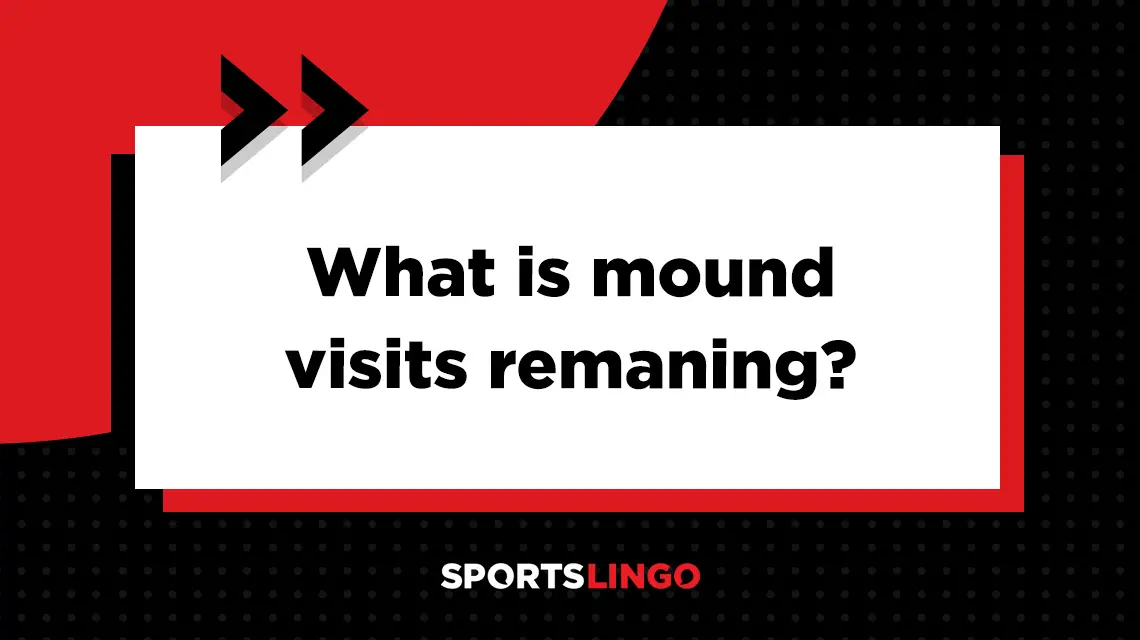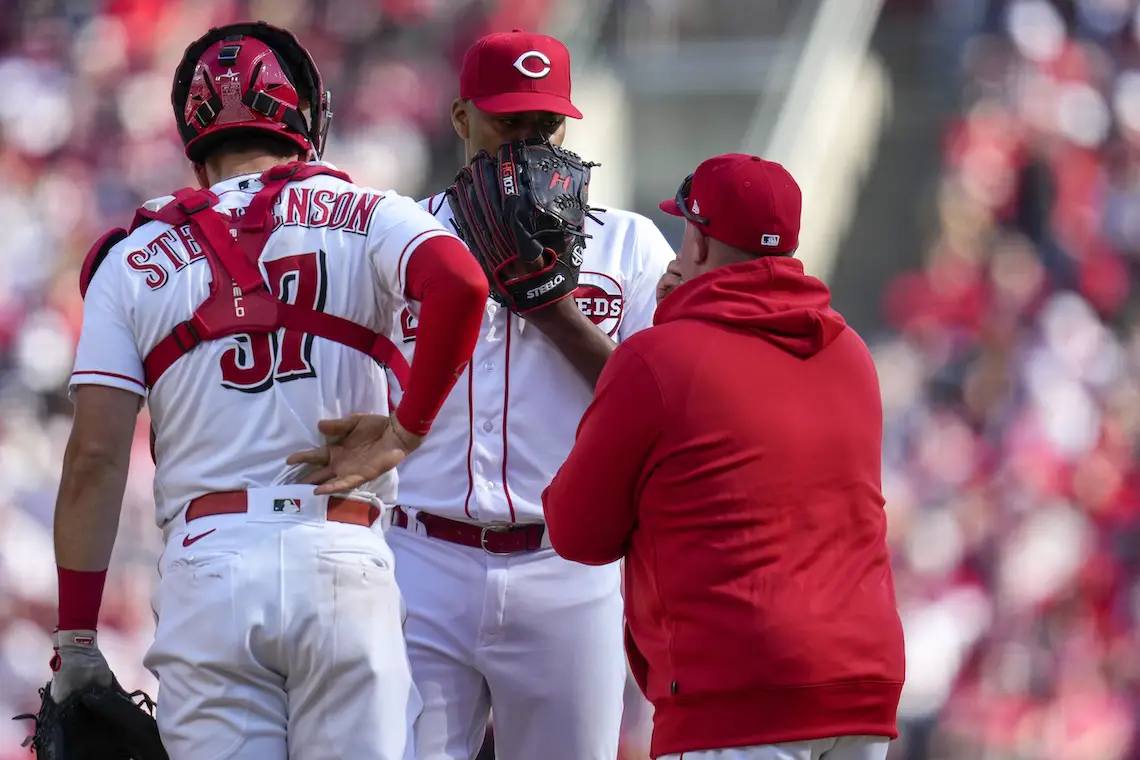
mound vi*sits re*main*ing
What is the definition of mound visits remaining in baseball?
1. Mound visits remaining is a number that represents how many more trips to the pitcher’s mound may be made by members of a baseball team during a game. A limit on the number of permitted mound visits only applies in Major League Baseball (MLB).
What does MVR mean?
MVR stands for mound visits remaining. The number of MVR is listed on baseball scoreboards in the MLB. Though it is a number tracked during games, MVR is not considered an official baseball stat.
What is the mound visit limit?
The mound visit limit is a restriction on how many times players or coaches may pause the game to go out to the pitcher’s mound.
How many mound visits can you have in MLB?
In Major League Baseball (MLB), the number of mound visits without a pitching change is limited to five per nine-inning game. An additional mound visit is allowed for every extra inning that a team plays.
Mound visits do not roll over from one game to the next if they are not all used. Each game resets with five permitted mound visits, plus additional visits for extra innings.

Thomas Shea/USA TODAY Sports
How long can a mound visit last?
Mound visits must last no longer than 30 seconds. A mound visit officially begins when a manager or coach exits the dugout and is granted time by the umpire. The visit ends when the manager or coach exits the 18-foot circle around the pitcher’s rubber.
What happens when you run out of mound visits in the MLB?
According to the MLB rule book, a manager or coach who crosses the foul line on the way to the mound after running out of mound visits must make a pitching change. Some of the specifics surrounding this penalty include:
- If this occurs during the at-bat of a substitute pitcher’s first batter, the substitute may only continue pitching for the remainder of that at-bat.
- If the team is forced to make a pitching change for exceeding their allowed number of mound visits and no relief pitcher is warming up in the bullpen, the manager or coach who violated the rule may face ejection from the game. The umpire may allow the relief pitcher extra time to warm up before entering the game.
- If a position player makes a mound visit once the team has already used up all of their allotted visits, the pitcher is not forced to leave the game. However, the position player could be ejected if they fail to return to their position when instructed to by the umpire.
The umpire is responsible for keeping track of the number of mound visits a team has made. They count each one and will let teams know if an additional visit to the mound is not permitted because they have already used up their allotted number of visits. Each time a mound visit is made, the umpire signals to the press box to indicate how many visits a team has remaining in that game.
What does it mean to have a mound visit?
A mound visit means that a one or more members of a baseball team go to the mound to talk to the pitcher. Mound visits can be initiated by players or members of the coaching staff. All of the following count as mound visits:
- A player leaving their position to go to the pitcher’s mound
- A manager or coach leaving the dugout to go to the pitcher’s mound
- The pitcher leaving the mound to confer with another player
If players or coaching staff members join a mound visit that’s already in progress, it does not count as a separate visit.
What is the purpose of a mound visit?
Visits to the mound are often made to discuss pitching strategy, such as which types of pitches to throw to which players. Often, this is communicated silently via signals between the pitcher and the catcher, but if more discussion is needed, then a mound visit may be warranted.
In some cases, baseball players in the infield come to the mound to discuss defensive strategy. Whether or not this includes pitching strategy, the pitcher’s mound is generally the designated meeting place on the field.
Mound visits may also be used to help settle a pitcher’s nerves or give them a quick break during a high-stakes game. Members of the coaching staff may walk out to the mound to give pep talks or advise pitchers on how to pitch to specific players.
When a new pitcher is coming in to the game, the pitching coach may make a mound visit in order to talk to the outgoing pitcher. This gives them an opportunity to explain the substitution while also giving the relief pitcher additional time to practice with warm-up pitches.
What is the difference between mound visits and bullpen visits?
A mound visit involves players or coaching staff members going out onto the field and having a discussion on the pitcher’s mound. This temporarily stops the game.
The bullpen is the designated area off the field where pitchers can practice. A bullpen visit involves a relief pitcher warming up before potentially going into the game.
Are there any exceptions to the mound visit rule?
The following situations do not count as mound visits:
- Players and the pitcher talking between batters in the normal course of play (as long as players stay in their positions)
- Players, managers or coaches visiting the mound when a pitcher is injured
- A player visiting the mound to clean their spikes (as long as they don’t confer with the pitcher)
- Players visiting the mound after an offensive substitution is announced (as long as the visit occurs before the next pitch or play)
- Players visiting the mound during a suspension of play when the umpire calls “time”
- Players visiting the mound after a home run (as long as the players return to their positions before the runner crosses home plate)
- Players visiting the mound during an inning break or pitching change
Mound visit exceptions for cross ups
A cross up in signs occurs when there is confusion between the catcher and pitcher about pitching signals. For example, a catcher might signal for a curve ball, but the pitcher throws a fast ball instead. This can be dangerous for the catcher since they don’t know which pitch to expect.
When cross ups happen, the catcher usually makes a mound visit to discuss it with the pitcher. This counts toward the mound visit total. However, when a team has already used all of their allotted mound visits and a cross up occurs, the umpire may allow the catcher to make a brief visit to the mound to clear things up.

Sam Green/USA TODAY Sports
Why is the number of mound visits limited?
The mound visit rule was put into place to keep up the pace of play during baseball games.
Each time a mound visit is made, there is a stoppage in the game. Having a limit to the total number of permitted visits to the mound helps to keep the action going so that games don’t drag on too long. This also helps fans stay interested since it limits the number of times the game is paused.
Is MVR posted on the baseball scoreboard?
Baseball scoreboards in the MLB feature the number of mound visits remaining directly on the scoreboard. MVR isn’t tracked in high school or college baseball, so it is not featured on the scoreboard for these games.
What does meeting on the mound mean?
Meeting on the mound refers to a mound visit in the MLB. Usually, this involves a manager or coach going out to the mound to discuss strategy with the pitcher. Occasionally, the pitcher’s teammates will initiate or join in a mound visit.
In the past, a mound visit was sometimes referred to as a pow wow, a term which references social gatherings conducted by indigenous Native Americans. Today, pow wow is rarely used to describe a meeting at the mound since this use of the term is offensive to many Native Americans.
When were mound visits first limited?
In 2016, the MLB instituted a baseball rule in which mound visits during games were given a 30-second time limit. Prior to this rule change, the only restriction on mound visits was that coaches were required to make a pitching change if they made a second visit to the mound in the same inning.
In 2018, the MLB instituted another rule limiting the total number of visits to six per nine innings. The mound visit rule was amended again in 2019 to limit the number of visits to five per nine innings.
What is the new mound rule in the NCAA?
A recent rule change in National Collegiate Athletic Association (NCAA) college baseball states that mound visits must be limited to 30 seconds long. However, there is no limit on the number of mound visits which may be made.
Example of mound visits remaining used in commentary
1. With one runner from the Atlanta Braves on first base, the New York Yankees are initiating their fifth meeting on the mound. After this, the Yankees will have no more mound visits remaining.
Sports the term is used
1. Baseball
Abbreviated as:
1. MVR